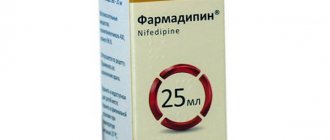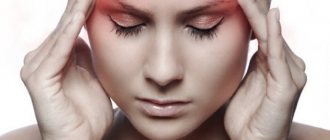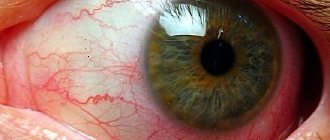Increased intraocular pressure is often observed after 40 years, but can also occur at an early age.
A persistent condition leads to the development of glaucoma, disruption of the movement of intraocular fluid and deterioration of vision, first in the periphery, then in the center.
To correct the condition, eye drops are used to lower intraocular pressure.
Their selection is made by an ophthalmologist based on diagnostic results, individual patient data, the presence of concomitant diseases, and additional medications used.
Intraocular pressure
Intraocular pressure Source: youtube.com The term intraocular pressure refers to the force exerted by the structures of the eye - aqueous humor and the vitreous humor - on its capsule.
Due to it, the tone of the organ is maintained. Normal intraocular pressure is created by the difference in moisture from the anterior and posterior chambers, which constantly decreases and enters. Thanks to this feature, the proper functioning of the eye system is ensured.
Intraocular pressure ensures the spherical shape of the organ, and also creates the necessary conditions for organizing nutrition processes of all structures.
Norms for eye pressure of a healthy person
The norm for eye pressure is from 10 to 23 mmHg. It is noteworthy that throughout the day the indicators can change; during the day they are usually higher, in the evening they are lower. However, the jumps are insignificant - no more than 3 mmHg.
Ophthalmotonus leads to vision problems and physical discomfort. It is typical mainly for people over 40 years of age. The most serious consequence of this phenomenon is glaucoma.
High pressure
Source: OverHealth.ru Increased eye pressure is called “ophthalmohypertension.”
High eye pressure is a fairly rare, but no less dangerous disease. It occurs due to the pressure of the contents of the eyeball on the outer shell of the eye - the sclera and cornea. It is especially well felt if you lightly press on the closed eyelids with your fingers, but patients often complain of heaviness and “bloating” of the eyes even in normal conditions. The pressure is especially acute against the background of other diseases - colds, runny nose, headaches.
Constantly increased eye pressure is called glaucoma. This is a serious disease that can lead to decreased vision or even complete blindness. Therefore, it is necessary to prevent the occurrence of such problems as early as possible.
Its reasons are the following:
- blood pressure surges;
- eye fatigue (watching TV for a long time or working at the computer);
- high intracranial pressure;
- stress and overexertion;
- disruptions in the functioning of the central nervous system and heart;
- kidney problems;
- menopause;
- poisoning.
These are just the most common causes of high eye pressure. Manifestations of ocular hypertension cannot be ignored. The symptoms are as follows:
- redness of the eyes;
- rapid eye fatigue;
- poor quality of vision at dusk;
- reduction of a person’s field of vision;
- pain in the temples and brow ridges;
- rainbow arcs and flies in the eyes when they come into contact with light;
- vision is rapidly deteriorating;
- severe discomfort for the eyes, which occurs almost constantly.
Low
Source: Serdce.guru This phenomenon is also called eye hypotony.
It is rare and has a direct relationship with the patient's blood pressure. With prolonged general hypotension, the pressure in the capillaries of the eyes decreases, resulting in ophthalmotonus. In addition to hypotension, the following factors can lead to it:
- previous surgical operation on the eye(s);
- inflammatory processes in the eyeball;
- foreign body in the eye;
- atrophy of the eyeball as a result of injury;
- retinal detachment;
- other pathologies related to the eyes;
- diseased kidneys;
- infection;
- dehydration of the body.
Eye pressure below normal is often manifested by dry eyes and lack of shine. Sometimes there is a general deterioration in vision. However, often this type of hypotension does not manifest itself in any way.
Causes
Normal eye pressure ranges from eight to twenty-six millimeters of mercury. With such indicators, a person feels comfortable, and the eye is not subject to unnecessary stress.
However, malfunctions often occur in the body, as a result of which the secretion of natural fluids of the eye increases, and the functioning of the heart and blood vessels is also disrupted, which leads to pressure surges. The cause of such failures can be stress, heavy stress (including mental stress), or a recent illness.
Another reason for increased intraocular pressure may be a change in the anatomical structure of the eye. The risk group includes people suffering from the following diseases:
- of cardio-vascular system
- atherosclerosis
- farsightedness
- having a hereditary predisposition
What causes the disease?
No one is immune from increased eye pressure. This is a common pathology that can lead to glaucoma, which can lead to vision impairment and even blindness. The pressure is especially strong during headaches, migraines and various colds. Its normal values are 8-26 mmHg. Art.
When a malfunction occurs in the body, increasing the secretion of eye secretions and disrupting the functioning of the cardiovascular system, the pressure inside the eyes rapidly increases. High blood pressure accompanies many eye diseases.
Before prescribing drops to reduce eye pressure, the ophthalmologist measures its value and looks for the cause of the disorder.
The main factors of eye pressure include:
- Stress.
- Chronic fatigue (mental and physical).
- Hypertonic disease.
- Pathologies of the thyroid gland.
- Kidney and heart failure.
- Neurological diseases.
- Neoplasms.
- Complications after illnesses.
- Changes in the structure of the eyes.
- Injury, inflammation of the eyeball.
- Cardiopsychoneurosis.
- Long-term use of steroids.
The disorder causes attacks of temporal pain, pain when moving the eyes, weakness, and lethargy.
Symptoms of the disease
When the disease just begins to develop, a person may not even notice it. Heaviness in the eyes and rapid fatigue are often attributed to overwork or lack of sleep.
However, it is impossible to get rid of increased intraocular pressure by sleeping for a couple of days: even if it subsides for a short time, the disease will return later. As the disease progresses, it becomes more noticeable and causes the patient a lot of anxiety.
The most noticeable symptoms include a sharp decrease in vision and frequent severe headaches, usually localized in the area of the eyes or temples. Also, those suffering from the disease experience redness of the eyes and blurred vision.
If you do not contact an ophthalmologist at this stage and do not take immediate action, you may lose your vision, since the optic nerve may atrophy due to prolonged pressure.
Therefore, if at least two of the symptoms listed appear within a few days, you should make an appointment with a specialist as soon as possible.
Treatment
Treatment depends primarily on the stage of development of the disease. If problems have only recently begun to appear and serious problems with the functioning of the eye have not yet been observed, fairly simple methods will help.
An ophthalmologist may prescribe eye exercises, wearing special protective glasses, and moisturizing eye drops. It is also necessary to limit eye strain, in particular, strictly control the amount of time spent at the computer or TV.
Important
It is worth excluding activities that require concentration and eye strain - knitting, beading, soldering, assembling models. Instead, it is better to go for a walk in the park or do gymnastics.
But strength or contact sports will need to be excluded, at least temporarily: regular stress and concussions will negate the effect of treatment. When the disease progresses rapidly, more serious measures are resorted to, including surgery.
There are two types of operations performed for increased intraocular pressure: excision of the iris using a laser; laser stretching of the trabecula. Both operations improve the release of excess secretion products, thereby reducing the pressure inside the eye.
In addition, if blood pressure increases, medication, instillation of special medications, and lifestyle changes may be prescribed. If the disease is advanced and eye glaucoma occurs, modern medicine is powerless to stop the regressive processes.
However, regular monitoring by specialists and strict adherence to their instructions will make it possible to live an almost full life, minimizing vision loss.
When it comes to your eyes, don't forget the importance of preventative measures to protect them. Unfortunately, most modern professions are directly related to a person’s constant presence in front of a computer monitor.
Therefore, in order to maintain good vision into old age, you need to remember about eye exercises and mandatory breaks during work. These measures will help prevent vision deterioration and symptoms of high or low eye pressure.
Drops to relieve eye pressure
There are many options for reducing high intraocular pressure. The most convenient way is to use drops. They have different mechanisms of action and composition, but all are aimed at maintaining the normal functioning of the organ of vision.
Depending on the main active substance, the products are divided into the following groups:
- cholinomimetics;
- carbonic anhydrase inhibitors;
- sympathomimetics;
- prostaglandin analogues;
- Complex means of combined action.
- beta blockers;
- alpha adrenergic agonists;
- combination drugs.
Depending on the cause that caused the increase in intraocular pressure and the characteristics of the patient, drugs of a specific mechanism of action are prescribed.
Drops are often used to treat the described pathology and for preventive purposes. They differ radically in their composition and mechanism of action on the human visual apparatus.
The choice of medications to restore vision by stabilizing intraocular pressure depends on the individual characteristics of the patient and the root cause that provoked the pathology.
Some drugs ensure normal outflow of intraocular fluid, while others reduce its formation, while others belong to the combined complex group.
Using glaucoma drops during pregnancy
During pregnancy, the use of medications for glaucoma is possible only as prescribed by a doctor.
These drugs have a number of undesirable effects on the fetus. There is no reliable, scientifically proven information about how drops act on the development of a child in the womb in modern medicine. And this carries considerable danger. After instillation of eye drops, some of the substances enter the bloodstream, and along with it to the placenta. During breastfeeding, substances pass into a woman's milk. This is an extremely dangerous disease for a pregnant woman. According to statistics, women of childbearing age rarely suffer from this ophthalmological disease, but if it occurs, it is necessary to be treated exclusively under the supervision of a specialist.
Beta blockers, miotics, carbonic anhydrase inhibitors, and prostaglandins are extremely unsafe for pregnant women. Beta blockers are not used in the first trimester due to the fact that they are very dangerous in the early stages of fetal development. Use in subsequent trimesters, as well as during breastfeeding, can lead to a decrease in the fetal heart rate and a decrease in blood sugar levels. Beta blockers can also interfere with normal uterine contractions and risk miscarriage.
Miotics are also prohibited for use in the first trimester, because they negatively affect the development of the child in the first months of pregnancy. During breastfeeding, they cause the newborn's body to become taller and weaker.
Drops with carbonic anhydrase inhibitors are safe medications for the fetus. But tablets with this substance lead to congenital disorders in the child.
Prostaglandins can trigger premature labor. During lactation, there are dangers of adverse reactions in infants.
Glaucoma itself is not an obstacle to conceiving and bearing a child. But the drugs used to treat it, reducing eye pressure, entering the blood of a pregnant woman or the milk of a nursing mother, can cause undesirable and dangerous consequences.
Cholinomimetics
Source: en.ppt-online.org The main drugs in this group are Carbacholine and Pilocarpine.
Treatment of intraocular pressure occurs by improving the outflow of fluid. Facilitation of its removal is observed when the pupil constricts and the muscles inside the eye contract. They combine well with medications from other groups. The property of the drug "Pilocarpine" is to contract the muscles of the eye through stimulation of the receptors. Then the pupil narrows and the pressure inside the eye decreases.
Indications for the use of drops are:
- Closed-angle and open-angle glaucoma.
- Retinal vein thrombosis.
- Obstruction of the arteries in the retina.
- Before the examination to constrict the pupil.
- Elimination of overdose symptoms when using pupil dilators.
- The recovery period after surgery.
To eliminate the symptoms of an overdose of drugs that dilate the pupil. Eye drops are not safe for patients with iridocyclitis, keratitis, or allergies to the components of the drug.
It is not recommended to use them after certain operations, when narrowing of the pupil can lead to complications.
Carbacholine is used to lower blood pressure. It has the same properties as Pilocarpine. Used only among patients with angle-closure glaucoma.
Prescription of the drug is prohibited in case of violation of the integrity of the cornea, bronchial asthma, angina pectoris and hypersensitivity to the active ingredients.
The main therapeutic focus of these drugs is to improve fluid outflow. Drops, which combine well with other medications, promote contraction of the intraocular muscles, narrow the pupil, which greatly facilitates the removal of moisture.
The drug Pilocarpine contracts the eye muscles by stimulating their receptors. Next, the pupil narrows, and the pressure decreases accordingly.
Contraindications
Cholinomimetics are not recommended for patients with allergic reactions to the components of the drops, keratitis, or iridocyclitis. Use is prohibited after surgery, when constriction of the pupil will lead to a serious deterioration of the condition.
In order to reduce pressure in the eyes, the drug Carbacholine is prescribed. It is intended for the safe treatment of patients diagnosed with angle-closure glaucoma. Contraindications include asthma, corneal disorders, allergic reactions, and angina.
Drops for the most effective reduction of pressure in the eyes
Drugs that reduce intraocular pressure are called beta-blockers, which act by inhibiting the receptors that produce moisture. The effectiveness of such medications is very high. Therefore, in the treatment of glaucoma and ocular hypertension (a pathology that does not lead to vision loss), they are prescribed first. This group primarily includes Timolol with Betoptik. It is these medications that are considered most effective in reducing pressure in the eyes.
The drug "Timolol", as already noted, acts directly on the lesions due to its active component of the same name. It significantly reduces the secretion of secretions that provoke eye pressure. It is important to use eye pressure drops only for diagnosed disorders. If the pressure is normal, it will be lowered under the influence of the medicine, which will negatively affect the person’s condition.
The Betoptik product has a similar effect on the body and, when used correctly, normalizes eye pressure in the shortest possible time. It differs from Timolol in that it prevents increased fluid production. Now let's move on to reviews of eye drops to reduce intraocular pressure.
Carbonic anhydrase inhibitors
A group of eye medications for high blood pressure is aimed at a special enzyme that is produced by the ciliary body. A change in its functioning leads to a decrease in the amount of moisture formed in it. For this purpose, the most effective and affordable drops “Azopt” and “Trusopt” are used.
They contain different active ingredients, and therefore the indications for use have some differences.
Azopt drops reduce the transport of fluid and sodium, which leads to a decrease in the formation of intraocular fluid. For this reason, high blood pressure is normalized. It is indicated for people with open-angle glaucoma.
Azopt is not prescribed to patients with kidney disease, and limited use is allowed for liver disease and closed-form glaucoma.
Trusopt eye pressure-reducing drops operate on the same principle. It is based on another active substance that allows you to expand the indications. It can be used by patients with open-angle (children and adults) and secondary glaucoma without a block in the anterior chamber of the eye.
This medication group is used for the development of glaucoma symptoms. The main action is aimed at the enzyme, which is produced in the ciliary body. When the function of the latter is impaired, the amount of moisture created decreases.
To prevent such transformations, ophthalmologists often prescribe Trusopt and Azopt drops to patients. They differ in indications for use because they contain different active substances.
Azopt minimizes the movement of sodium and fluid, resulting in reduced moisture production within the visual system. As a result, normalization of pressure is observed.
Azopt is often prescribed to people diagnosed with open-angle glaucoma. Such drops should be used with caution in cases of closed glaucoma and chronic liver diseases. Contraindication: kidney pathologies.
Trusopt drops are characterized by a similar effect. Their active component, dorzolamide hydrochloride, effectively copes with high blood pressure, which progresses against the background of intraocular hypertension or glaucoma. The drug has virtually no contraindications, which explains its widespread use.
Sympathomimetics
Source: moi-oftalmolog.com The action of the drugs is based on their effect on cell receptors.
Many patients are prescribed Oftan Dipivefrin drops to reduce eye pressure. They temporarily increase fluid production and then significantly reduce its amount. At the same time, the pupil dilates. "Oftan Dipivefrip" is indicated for people with narrow-angle glaucoma and that occurred in the operated eye due to cataracts. Drops for eye pressure are not prescribed if you are allergic to the components of the drug or if the angle of the anterior chamber of the eye is blocked.
This group of medications has a direct effect on receptors (at the cellular level). The drug Oftan Dipivefrin is widely used.
Feature of drops
The peculiarity of these drops is that the resulting liquid increases, after which its amount decreases, and the pupil dilates.
The drug is indicated for open-angle glaucoma that forms after surgery (cataract). Contraindications: blockage of the angle of the anterior eye chamber, allergy to any of the components.
This medication group is considered the most effective and safe. The therapeutic effect is observed after 1.5-2 hours after using these medications.
Special gymnastics
It was developed by qualified specialists. Special gymnastics also helps to stop the manifestations of IOP. Exercises to reduce eye pressure must be performed at least three times a day.
The simplest and at the same time effective techniques are listed below:
- Frequent blinking for a minute.
- Turn your eyes clockwise and counterclockwise. They should be performed with closed and open eyelids.
- Shifting the gaze from a distant object to a near one. It is most convenient to do it while looking out the window.
- Drawing shapes, numbers and letters with your eyes.
The listed exercises not only help to cope with pathology. They improve the nutrition of eye tissues and the functioning of the visual apparatus.
Beta blockers
Source: aptekavita.ru Ophthalmic drops for high eye pressure have similar properties to drugs for systemic administration.
The action is based on reducing the amount of moisture. When instilling the medicine, it is recommended to close your eyes for 2-3 minutes. During this time, beta blockers will begin to have only a local effect, and will practically not penetrate the nasolacrimal duct.
If you do not adhere to the recommendations, then drops from high eye pressure, once in the bloodstream, will negatively affect the cardiovascular and endocrine respiratory systems. To reduce the risk of side effects, more modern drugs are prescribed.
These include Timolol and Betoptik. The first drug is well tolerated and patients practically do not note increased heart rate as one of the possible phenomena. Eye pressure drops not only inhibit the formation of aqueous humor, but also facilitate its outflow.
Timolol has no effect on the pupil and therefore does not impair the patient’s visual acuity. Prescribed for symptoms of primary open-angle and secondary glaucoma. The product has a number of contraindications for use, which include:
- The patient's age is under 18 years.
- Bradycardia (heart rate less than 60 beats per minute).
- Chronic diseases of the respiratory system with obstruction.
- Heart failure.
- Dystrophic changes in the surface of the cornea.
- Drops should be prescribed with caution during pregnancy, diabetes, and thyrotoxic goiter.
Betoptik normalizes increased intraocular pressure using the same mechanism as Timolol. In contrast, this drug selectively acts on the receptors of the cells of the organ of vision, which respond to the formation of fluid in it.
In addition, they penetrate well through the cornea and accumulate in tissues. This leads to side effects from beta blockers.
"Betoptik" is prescribed to patients to treat open-angle glaucoma and reduce the tone of the eyeball. The drug has the same list of contraindications as Timolol.
The action of such drugs is aimed at reducing the level of moisture produced. After instilling the eye drops, close them for a few minutes. During this time, beta blockers will have a local therapeutic effect, but will not have time to pass into the nasolacrimal ducts.
If these conditions are not met, the drops will enter the circulatory system, which can negatively affect the functioning of the respiratory, endocrine, and cardiovascular systems.
Modern antiglaucoma drops, tablets, and other forms of medications are practical to use and highly effective, as they cause almost no side effects. Among beta-blockers, drugs such as Timolol and Betoptik are often prescribed.
Timolol is well tolerated by patients in almost all cases; in exceptional cases, an increase in heart rate is noted. The action of these drops is aimed at preventing the formation of excess moisture and its unhindered outflow.
Due to the fact that Timolol does not affect the pupil, there is no distortion of vision clarity. A drug is prescribed to stabilize pressure in the eyes of adults with primary (open-angle) and secondary glaucoma. If thyrotoxic goiter is diagnosed, the drug is used under the supervision of a specialist.
As for the drug Betoptik, its mechanism of action is almost similar to the previous description. If your eyes are swollen, ophthalmologists often prescribe such drops. They are distinguished by a selective effect on the cellular receptors of the eyes, which are responsible for the production of fluid in them.
The active substance penetrates the cornea and can accumulate in soft tissues, resulting in side effects characteristic of beta blockers. Purpose: decreased tone in the eyeballs, open-angle glaucoma.
Side effects of eye drops
- discomfort when blinking;
- development of conjunctivitis;
- changes in the color of the cornea, pupils;
- the appearance of swelling of the mucous membrane;
- allergy.
Despite the fact that such drugs act painlessly and directly on the lesion, in rare cases they provoke bronchial spasm or disruption of the heart muscle.
To prevent the deterioration of your own health, you should not engage in self-treatment. When the first symptoms of the disease appear, consult a doctor who will select the appropriate therapeutic method. The norm is approximately 12–20 mm. If the range is less than 12 mm, it means that the person has hypotony of the eye. If the range is greater than 20–22 mm, the condition is called ocular hypertension. Contact or non-contact tonometry is used for measurements. If tonometry reveals deviations from the norm, additional diagnostics will be needed to identify the causes in order to then treat with eye pressure pills.
Possible changes that fluctuate from season to season are considered normal and are not a cause for concern, also affected by fluid intake and exercise, which may change heart rate or breathing. Temporary changes may also occur depending on alcohol consumption, vomiting, coughing, and coffee consumption.
Types of medications
- Sympathomimetics. They affect the eyes and the human nervous system. Side effects include severe redness of the eyes, changes in heartbeat and enlarged pupils.
- Cholinomimetics. They constrict the pupil. The patient will feel better after using the medicine. The main disadvantage of the drops is their short duration of exposure (no more than 6 hours).
- Prostaglandins. Prostaglandins are drops that significantly reduce fluid flow. This remedy is effective for no more than 24 hours. After using medication for high eye pressure, there may be a slight burning and redness of the eyeball. In order to reduce blood pressure, tablets such as Acetazolamide, Dorzamed solution, and Brinzolamide suspension are used.
- Acetazolamide. Used for glaucoma, various side effects may occur. The dosage of the medication should be checked with your doctor. This substance is one of the most important and necessary types of medicine.
- Dorzamed. Apply 2-3 times a day, one drop in each eye. Prescribed for various types of glaucoma.
- Timolol. When glaucoma is diagnosed, the drug Timolol is used to reduce eye pressure. Helps with various forms of glaucoma and should be taken before bed. Use only after consulting a doctor, as the medicine can both lower and increase blood pressure.
- Betoptik. The medicine fights glaucoma and improves vision. It can only be used twice a day. Betoptik will begin to act in 1–2 hours.
There are side effects:
- Tearing.
- Photophobia.
- Redness of the cornea.
- Discomfort.
- Insomnia.
- Depression (short-term).
The reaction to it is strictly individual; when taking it, medical supervision is required.
"Xalatan" belongs to the group of prostaglandins and is considered effective. It works for a long time (about a day), unlike the above. It has the following side effects: increased pigmentation of the iris, conjunctivitis, blurred vision, allergies.
- It is necessary to wash your hands well with soap to prevent germs from entering the eye.
- Pull up your upper eyelid and look up.
- Drop one drop of the medicine.
- Close your eye and lightly press on it, stay in this position for about 2 minutes.
It is not recommended to use more than 2 drugs for eye pressure at the same time; if this is necessary, self-prescription is excluded, consultation and supervision of a specialist is required. Before using the drops, contact lenses are removed; any discomfort cannot be tolerated; if an allergic reaction occurs, the drug is replaced.
Important!
If the patient uses soft lenses, they will need to be removed before instillation. If the patient’s hands are shaking, then he needs to turn to his family for help. In order not to harm the eye, you should not use drops for longer than necessary, as this may cause even more problems.
The patient may experience dryness and allergies after instillation into the eyes; you need to make an appointment with a doctor, since it is possible that the drug you are taking for this ailment is simply not suitable for you. After the consultation, the doctor will change the medicine and prescribe one that will promote a speedy recovery.
Alpha adrenergic agonists
To relieve high intraocular pressure, some patients are prescribed drugs from the group of alpha-adrenergic agonists. Their use is limited due to the large number of side effects. The drops contain clonidine.
Specialized clinics use the only remedy - Brimonidine. The drug is used if there are contraindications to the use of beta-blockers and open-angle glaucoma. It is not prescribed to children under 2 years of age, or to patients taking antidepressants.
If persistently high pressure inside the eyes is diagnosed, in some cases medications related to alpha-agonists are used. Their use is strictly limited as many patients experience adverse side effects.
These drugs contain clonidine, a potent substance, they are prescribed if there are contraindications to beta-blockers, and if open-angle glaucoma is diagnosed. Contraindications: use of antidepressants, childhood.
Indications for use of Timolol
Timolol eye drops are used in a number of the following cases:
- With increased intraocular pressure and to prevent its complications.
- As part of primary open-angle glaucoma.
- Against the background of secondary glaucoma (including post-traumatic, uveal and aphakic forms).
- For congenital glaucoma as an adjuvant therapy.
- Against the background of angle-closure glaucoma in complex treatment with miotics.
- Against the background of an acute attack of increased pressure inside the eyes.
Now let's talk about how to use the drug Timolol.
Combination drugs
Source: od-os.ru Anti-pressure eye drops of combined action are increasingly being used for treatment.
The advantage of the drugs is their pronounced hypotensive effect due to the combination of several active components. They also do not require frequent use during the day. To normalize eye pressure, Fotil (combines pilocarpine and timolol), Xalacom (a combination of xalatan and timolol) and Cosopt (trusopt and timolol) are most often used. Xalacom is prescribed to patients with open-angle glaucoma or insufficient effect of treatment with drugs from other groups.
Contraindicated in patients under 18 years of age, with diseases of the respiratory system with obstruction and heart failure. The drug "Fotil" is used for primary and secondary glaucoma.
It has the following number of contraindications:
- Bronchial asthma.
- Postoperative period.
- Age up to 18 years.
- Bradycardia.
- Respiratory diseases with obstruction.
It is contraindicated for persons with diseases of the respiratory system, heart failure, pregnancy, breastfeeding and patients under 18 years of age. If you have elevated intraocular pressure, you should not self-medicate.
All drugs reduce it by acting according to a specific mechanism, but they can also have side effects. To avoid them, the doctor takes into account all the patient’s contraindications. If necessary, several types of drops from different groups are prescribed or they are changed to others if the treatment is ineffective.
For the eyes, if high blood pressure is detected, combined action drops are often used. Such drugs usually contain several active substances at once, due to which a persistent hypotensive effect is achieved.
Fotil, drops based on pilocarpine and timolol. Pilocarpine reduces pressure and constriction of the pupils by acting on muscarinic receptors. It is quickly absorbed into the cornea after contact with the surface of the eye.
The effect appears after 10 minutes and lasts for several hours. Timolol is a beta blocker that penetrates the structures of the ciliary body that secretes intraocular fluid, significantly reducing its production.
The substance improves blood circulation in the retina and is not addictive. Drops are used only in the affected eye. The dosage and duration of the course are determined by the doctor. Xalacom works an hour after application.
The therapeutic effect lasts 6-8 hours. The drug is based on timolol and latanoprost. Latanoprost quickly penetrates the cornea, accumulating in the ocular fluid. Excreted naturally. Does not affect metabolic processes.
Cosopt is based on the beta blocker timolol and dorzolamide. Reduces eye pressure, reducing the production of eye secretions when the outflow from the organ is impaired. Moisture accumulates more slowly, does not put pressure on the optic nerve and does not cause its deformation.
Composition of eye drops
The drugs are stable, sterile oily or aqueous solutions or suspensions of medicinal substances. The composition of eye drops is different and is a factor in the classification of the product (the active component determines the group of the drug). Thus, antiglaucoma eye drops, depending on the substances they contain, are divided into beta blockers, prostaglandins, cholinomimetics and analogues of these agents. The positive effect of therapy is achievable thanks to the two-component composition of medications. Examples of the composition of popular drugs:
- Xalac consists of xalatan and thymol;
- Fotil contains thymol and trusopt.
How to instill drops?
Source: aloe-farm.ru It is not difficult to use eye drops for eye pressure.
The only condition is clean hands. It is very easy to introduce germs into the affected eye, but getting conjunctivitis with existing diseases is quite unpleasant. The procedure is carried out as follows: Throw back the head, having previously taken a stable position. The lower eyelid is carefully grabbed with a finger and pulled back a few millimeters. Drops are applied to the inner part of the eyelid (mostly all bottles have an easy-to-use dispenser).
Do not touch the tip of the dispenser or pipette to your eye. After applying the medicine, close the eye for a few seconds. When using eye drops, patients feel a slight burning sensation and increased release of moisture.
Important
There should be no pronounced painful sensations. Drops are stored in a cool, dark place. If the drug according to the instructions needs to be stored in the refrigerator, it should be slightly warmed in the palm of your hand before instillation.
Cold liquid causes lacrimation, in which most of the medicine leaks out and does not have time to be absorbed into the cornea.
Some drugs begin to act after accumulation in the body, some lose their healing properties over time. In this case, you must inform your doctor.
To prevent sustained action, it is recommended to change eye pressure drops every 1.5-2 years. Timely measurement of eye pressure will help you choose the right drug and dosage, which is important for a successful outcome.
How to lower eye pressure?
When tingling, pain, redness, swelling and itching occur during treatment with drops, it is necessary to carefully rinse the eye and immediately see a doctor. You should purchase medications exclusively from pharmacy chains and be sure to check the expiration date.
In order for the treatment of high blood pressure and the prevention of glaucoma to give positive results, using medications alone is not enough.
Eye gymnastics and doctor’s recommendations will help normalize blood pressure, allowing you to achieve the desired improvement:
- Limit eye focusing at close range.
- Watching TV, working on the computer, reading, writing should not last longer than 4 hours with breaks of an hour.
- Identify and treat the disease that causes hypertension inside the eyes.
- When using eye pressure drops, do not drink alcohol.
- Salt, coffee, strong teas and energy drinks should be limited as much as possible in your diet.
- Do not lift weights weighing more than 10 kg - this can damage the optic nerve.
- You need to sleep on a voluminous pillow so that your head rises above the level of your body.
In case of ocular hypertension, it is necessary to systematically measure eye pressure. Drops are instilled from 2 to 10 times a day, depending on the medication. Blood pressure lowering agents are potent, so the dosage must be strictly followed. If the effect of the drug weakens over time, you should inform your doctor.
Urgent help
In case of an acute attack of glaucoma, you should call an ambulance, as the patient risks losing his vision. If eye pressure has jumped significantly, it is useless to use the prescribed drops in a larger dosage.
Doctors use other drugs to urgently lower blood pressure. Pilocarpine is instilled in a 1% solution drop by drop every 15 minutes. Use Timolol in a 0.5% solution, one drop twice a day.
Glycine and diuretic solutions are administered intravenously. The disease worsens with severe fatigue and non-compliance with the rest regime. In order to avoid serious consequences, it is recommended to follow the doctor’s prescription, use eye drops for eye pressure and give your eyes a rest.
Lifestyle change
Race walking, jogging, cycling - all this helps relieve eye pressure. As a rule, you need to spend at least 30 minutes a day playing sports. However, any load should be previously agreed upon with the attending physician.
Patients with ocular hypertension are advised to sleep on high pillows. In addition, it is important to reduce the time spent at the computer and other activities that are associated with increased stress on the visual system.
Nutrition plays an important role. Doctors advise patients to eat foods rich in polyunsaturated fatty acids 2-3 times a week. First of all, it is a variety of seafood. Additionally, you can consume fish oil in tablet form. Products with lutein and zeaxanthin (spinach, egg yolks, broccoli) are also useful. Currants and blueberries have a beneficial effect on eye health. In general, the menu should be balanced, enriched with vitamins and microelements.
Other means
Source: Glaza.guru Most cases of ocular hypertension are caused by a hypertensive crisis or eye injury.
If your blood pressure spikes, you need to be observed and treated by a cardiologist. Increased eye pressure without appropriate treatment is dangerous. You can slow down vision loss in other ways in combination with the prescribed treatment: Do special gymnastics, which the ophthalmologist will tell you about. Buy suitable glasses - these are also prescribed by your doctor. Apply cool compresses to your eyelids.
Give your eyes a rest when focusing close. Do not develop infectious eye diseases. When complex treatment is unsuccessful, laser or surgical intervention is recommended.
You can balance the pressure in the eyes using a laser by making a tiny hole in the iris. Such operations, even with a successful result, relapse in every fourth case. Therefore, it is better not to take it to extreme measures, but to consult a doctor in time.
With a competent approach (special eye exercises, proper nutrition, rest regimen, drops for eye pressure in a strictly prescribed dosage), the disease can be stopped and the patient’s condition improved.
Help from traditional medicine: external remedies
Traditional healers know how to relieve eye pressure. For example, various plants are used to prepare drops. You must first check whether you are allergic to them. The test is performed on the inside of the elbow.
Solutions are used for washing, instillation and lotions. Let's look at the most popular recipes:
- Aloe juice. You will need to chop 2 large leaves of the plant, pour boiling water over it and leave to simmer over low heat for 20 minutes. Afterwards the broth needs to be cooled. A cotton swab should be soaked in liquid and squeezed out. Wipe your eyes from the outer corner to the inner.
- Mashed potatoes. 2 tbsp. l. The product should be mixed with a teaspoon of 6% vinegar and transferred to gauze. The resulting lotion is applied to closed eyes for 10 minutes.
Doctors also talk about the benefits of contrast showers. It helps improve vascular tone.











